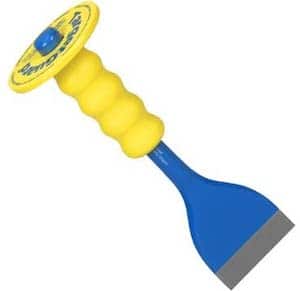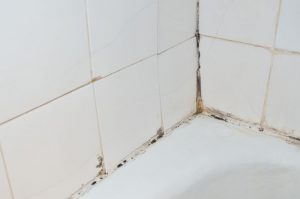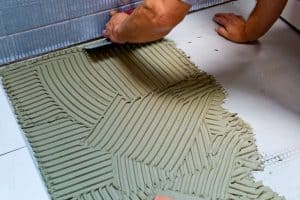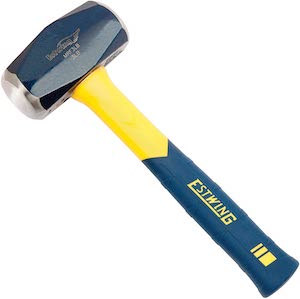How to Check for Mold Behind Shower Tiles
Mold in your home can be dangerous, no matter what room it’s located in. Mold can cause negative effects on family members’ health and cause your bathroom to be musty and unsanitary. If you have a bathroom that has shower tiles, you may be wondering how to check to see if there is mold behind the shower tiles.
So, how do you check for mold behind shower tiles? The only way to check for mold behind shower tiles is to remove the shower tiles altogether. Here are the steps to the process:
- Remove the Shower Tiles
- Check to See If There is Existing Mold
- Have a Professional Biohazard Cleanup Company Remove the Mold
- Re-Tile Your Bathroom
Once you discover mold growing in your bathroom, it’s important to act fast in order to reduce the effect and spread of the mold. Keep reading to get an in-depth look at checking behind your shower tiles for mold.
Remove the Shower Tiles
Unfortunately, the only way to check behind shower tiles for mold is by removing the shower tiles from the wall. Mold can hide behind shower tiles when the tiles have not been correctly caulked, grouted, and cemented down. Moisture gets in between the tiles and the walls and mold forms.
To remove shower tiles from the wall, you’ll need a hammer and a chisel. You’ll hammer the chisel between the tile and the wall to pry the tile away.
Mold will usually form behind the shower tiles closer to the foot of the shower, but this doesn’t mean that it doesn’t form in other areas. Start removing tile from the top corner of your shower and work your way down.
Tools Needed to Check Behind a Shower Tile:
Hammer: The Sure Strike drilling hammer from Estwing will help get the job done. This hammer is designed for striking tile chisels. Both faces are beveled. Make sure to protect your eyes from flying tile chips and dust. Always wear safety goggles.
Tile Chisel: The Worksite 12 inches Heavy Duty Masonry Chisel has a hand protection cover.
Go gently and try not to break or smash the tiles.

Check to See if There is Existing Mold
Once you remove the tile, check to see if there is any existing mold. Mold can be easy to spot, as it will usually be a dark slimy substance compared to the rest of the wall.
In a bathroom, mold can appear as black circles and dots on your wall or as a large black clump in the corner. If you see these signs, then you probably have mold.

Mold behind tiles in shower.
Have a Professional Remove the Mold
If you have found mold in your bathroom and behind shower tiles, do not try to remove it yourself. Mold needs to be handled by professionals since it can easily release toxins into the air and leave spores behind to re-grow.
Call a mold remediation company to rid you bathroom of mold. These professionals will have the proper gear and the proper know-how to get the job done and make sure that no mold was left behind.
Will your homeowner’s insurance cover mold removal? Read our article What Does Homeowner’s Insurance Not Cover?
Re-Tile Your Bathroom
The next thing you’ll want to do once the mold has been removed from your bathroom is that you’ll want to re-tile the wall. If done correctly, tile is one of the best materials to have in your bathroom to protect your walls from getting mold.
It’s important to make sure that the new tile is applied to the wall correctly and grouted and caulked so moisture can’t get in between the tile and the wall.

Retile the shower once the mold has been removed.
How to Tell if Your Bathroom Has Mold
While mold behind your shower tiles can be difficult to diagnose, there are some visible ways to notice whether or not you have a mold problem in your bathroom. They are as follows:
1. The Tiles in Your Bathroom Have a Muddy Look
Do the tiles in your bathroom look as if someone walked across them with muddy boots? If so, that “mud” can be mold. Mold and mildew can most often give you bathroom a muddy look. Luckily, this mildew is easy to remove with a bathroom disinfectant.
2. You Can Visibly See the Mold Around the Tiles and Tub in Your Bathroom
Are the tiles around your tub or shower clearly outlined by a dark color? If you answered “yes” to this question, then you have mold in your bathroom. An easy way to tell if your tub or shower has mold is that a dark mold will grow in the corners and around each individual tile square.
How to Prevent Mold In Your Bathroom
Once you go through one mold remediation, you never want to go through another. Here are some steps you can take to prevent mold from growing in your bathroom again:
1. Wipe Down the Walls After a Shower
To prevent mold from growing in your bathroom walls, wipe down the walls with a towel after every shower. This will help to collect any excess water that can be absorbed into the wall and cause mold to grow.
Bathroom walls are usually the most over-looked when it comes to the care of one’s bathroom; however, the walls of the bathroom are where a lot of molds can grow. If your walls get mold in them, the biohazard cleanup process could see entire walls ripped out and replaced.
Have you ever gotten out of the shower and seen water droplets running down the wall? Many times, we get out of the shower and completely ignore the fact that the bathroom walls are dripping with water. This is how mold can form in your walls.
Water damage can not only cause serious structural damage to your home, but it can also decrease the home value. To know more, read our article Does Water Damage Decrease Your Home Value?
2. Don’t Leave Your Bathroom Door Shut
One way to prevent mold from growing in your bathroom is to leave your bathroom door open whenever it isn’t in use. Many families like to close the bathroom door since it’s a place of privacy; however, doing this can keep the bathroom poorly-ventilated and dark, the perfect circumstances for the mold to grow.
Leaving the bathroom door open will allow for moisture in the bathroom to alleviate and the damp air to circulate out. If your bathroom has a ceiling fan or a window, you can turn on the fan or crack the window to help with the airflow.
3. Clean Your Bathroom Regularly
Cleaning your bathroom regularly will help remove any bacteria from your bathroom that could later turn to mold. Removing shower grime from your tub and tiles will keep mold from forming in these areas.
Treat Mold As Soon As You Notice There May Be a Problem
It’s important to treat mold as soon as you realize there may be a problem. Mold can grow rapidly and cause negative health effects for you and your family. Taking care of it as soon as you see the signs will save you time and money in the long run. If you notice mold in your bathroom, contact a mold remediation company to properly remove the mold.
Has a mold problem caused you to do a complete bathroom renovation? If this is you, check out our article Bathroom Renovation: Mold Removal Guide.


